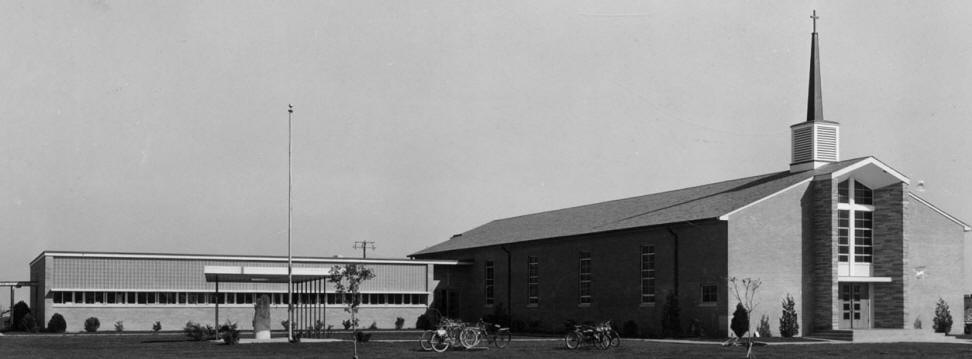|
Holy Cross Catholic Church
2001 Katy Street
28°59'4.70"N 95°57'0.43"W |
|
|
By 1880, the Catholic faith was still growing in New Orleans under the direction of Archbishop Francis Xavier Leray (1825-1887), with the help of the local Jesuit order.
Louisiana Bowie’s visit to New Orleans and subsequent baptism, would also change the lives of all Catholics in Matagorda County, Texas along with her desire to share her newly acquired faith with her family and friends; beginning the first efforts to aid in the establishment of the Catholic Church in Matagorda County and Bay City, Texas.
Matagorda County was one of the original twenty-three counties created when the Constitution of the Republic of Texas was adopted on March 17, 1836. On May 4, 1847, the new frontier diocese (Galveston) was first established by Pope Pius IX under the direction of Bishop Jean Marie Odin. (1800 – 1870)
In the 1850’s, many Polish Catholic
immigrants arrived in Matagorda
County. Their love for their faith was so great that they procured priests from
Brazoria, Liberty,
Galveston and Houston to visit
their small community, St. Francisville, which was lovingly known as the
“Polish Village.” Beginning in 1885 the Matagorda
County area was considered a “mission” of Annunciation Parish of Houston,
Texas. Mass was said in the home of Frank Seerden and his wife, Mary
Petrucha Seerden.
In 1895, the Seerdens and Mrs. Seerden’s
nephew, Zeflick Butter, donated land for the construction of a church
building. On December 21, 1895, The Right Reverend Nicholas Aloysius
Gallagher (1846 – 1918), from the diocese of Galveston, and Father M. P.
McSorley consecrated the St. Francisville Catholic Church, becoming the
first Euro-American Roman Catholic Church in Matagorda
County.
The Thompson-Chinn family lived across Caney Creek from the Bowie Plantation. The George J. and Frances S. Bowie family came to Texas in 1850. George J. Bowie was either drowned or frozen to death along with twenty-one other young soldiers in Matagorda Bay during the Civil War. They were attempting to defend the peninsula from the enemy.
Well-known, Galveston architect, Nicholas Joseph Clayton (1839 – 1916), was commissioned to design and construct the new structure. Clayton was himself a practicing Catholic, who had designed many churches, homes and commercial buildings in Texas. Nicholas Clayton was born in Cork, Ireland on November 1, 1839 and came to America as a child. At the age of twenty-eight, he decided to become an architect and acquired a job with the firm of Jones & Baldwin of Memphis. In 1872, the firm sent Clayton to Galveston to be the supervising architect for the construction of the First Presbyterian Church and the Tremont Hotel. There he remained until his death in 1916. Clayton also designed the famous Bishop’s Palace in Galveston which was begun in 1886 and completed in 1893 at a cost of $250,000.
In August 1908, Clayton completed his
plans for the “Church of the Holy Cross” in Bay City, Texas. It would be Clayton’s
last church building. The building was completed in May, 1909 and
dedicated by Father Jacob B. Schnetzer. The bell atop the new structure
was blessed by Father Ropps.
Between 1909 and 1910, Monsignor
Schnetzer, with the assistance of priests from the Oblate order, Father
J.P. Cuny, Father T.D. Hudon, Father Esteban de Anta and Father William
Lang, continued serving the mission churches in the surrounding area,
including Bay City. These priests would hold Mass once or twice a month
in any one location, due to the vast area they served. Rosenberg,
Velasco, Brazoria, Eagle Lake, Glen Flora, Wharton,
Alcoa, Alvin, Danbury, Needville, Wadsworth,
Francisville and Matagorda, were just a few of the other communities
they served as traveling priests. The priests would arrive from Houston
on the Brownsville train. Monsignor Schnetzer would later become the
superintendent of schools for the Galveston Diocese in the late 1930’s.
Over the next two decades, Holy Cross
parish continued to grow and prosper. In 1940, under the direction of
Father George Elmendorf, Holy Cross
Church opened a Catholic grade school next door to its sanctuary. The first
teachers were two Benedictine Oblate Sisters from
England. The Sisters of the Incarnate
Word and Blessed Sacrament now serve the school from Victoria, Texas. It continues to serve
the educational and spiritual needs of some one hundred thirty-two
students.
In 1943, Monsignor Christopher J. Martin
(1900 – 1989) succeeded Father Elmendorf at Holy
Cross Church. Christopher
Joseph Martin was born in a small village in Ballagh, County of
Tripperary, Ireland. The idea of becoming a priest came about as a
child. Young Martin would travel about in a pony and trap steered by a
retired priest, Father McKeogh, and answer the rosary, as it was the
priest’s custom to say it during his journey.
More property was purchased from Carrie
Robbins Rugeley in 1945, Lots 1 - 3 of Block 174, to expand the
ever-growing parish, but by 1948, Holy Cross parish had out-grown its
facilities and it was evident that a new building plan was needed.
Monsignor Martin and parishioner Edward Baca (1914 – 1993) traveled to
Galveston to present plans for the purchase of land and the building of
new facilities on the outlaying area of Bay City, to the Most Reverend
Christopher E. Byrne. Bishop Byrne approved the plans and a new era in
Holy Cross
Church history was beginning.
On
April 3, 1948, Holy Cross
Catholic Church purchased two tracts of land from the T.M. Thompson
Estate: I & G N AB. 270, TR 20- 9.85 acres and I & G N AB. 271, TR 2-
3.65 acres, on the corner of State Highway 35 and Katy Avenue, at a cost
of $3,500. The architect of the sanctuary, school, rectory and convent
was the firm Golemon & Rolfe of Houston, Texas. The new facility was to
be a handsome contemporary church, a modern school building, a rectory
and convent, all constructed of brick. The church building boasted a
small bell tower on the roof with a Verdin stationary church bell that
rang with the help of a mechanized bell ringer. In the winter of 1949,
the new $500,000 facility was dedicated with Monsignor Christopher
Martin and the Most Reverend Wendelin J. Nold (1900 – 1981), bishop of
the Houston – Galveston Diocese.
|
|
|
IN MAY 1847, THE CATHOLIC CHURCH ESTABLISHED A NEW FRONTIER DIOCESE IN GALVESTON. DURING THE NEXT SEVERAL YEARS, MANY POLISH CATHOLIC IMMIGRANTS MOVED TO MATAGORDA COUNTY, AND PRIESTS FROM NEARBY TOWNS VISITED THEIR SMALL COMMUNITY, KNOWN AS ST. FRANCISVILLE. IN THE LATTER PART OF THE 19TH CENTURY, LOUISIANA THOMPSON BOWIE WAS INSTRUMENTAL IN BRINGING THE PRIESTS TO DELIVER MASS TO AREA RESIDENTS. BORN TO ANN TALIFERRO AND ELBERT A. THOMPSON INS 1848, LOUISIANA GREW UP ACROSS THE CANEY CREEK FROM HARRIS WALKER BOWIE, WHOM SHE MARRIED. ON APRIL 13, 1895, WHILE IN NEW ORLEANS, SHE WAS BAPTIZED INTO THE CATHOLIC FAITH AT IMMACULATE CONCEPTION PARISH. BACK IN TEXAS, AT HER HOME ON THE BOWIE PLANTATION, SHE ARRANGED FOR PRIESTS TO STAY WITH HER FAMILY AND TRAVELED WITH THEM TO THE CHURCH IN ST. FRANCISVILLE. BAY CITY BECAME MATAGORDA COUNTY’S SEAT OF GOVERNMENT IN 1895, AND VISITING PRIESTS HELD MASS IN THE COURTHOUSE OR IN PRIVATE HOMES. MONSIGNOR JACOB B. SCHNETZER BECAME PRIEST FOR THE BAY CITY AREA IN 1907, BY WHICH TIME THE BOWIES LIVED IN THE GROWING TOWN; SCHNETZER STAYED IN THEIR HOME. IN MARCH 1907, HE BOUGHT LOTS AT AVENUE M AND FIFTH STREET TO BUILD A SANCTUARY FOR THE BAY CITY PARISH. DESIGNED BY PROMINENT GALVESTON ARCHITECT NICHOLAS CLAYTON, THE STRUCTURE SERVED THE CONGREGATION FOR MANY YEARS. AS THE CHURCH GREW DURING THE 20TH CENTURY, IT BUILT NEW FACILITIES, INCLUDING A RECTORY, SCHOOL, NEW SANCTUARY AND OTHER FACILITIES. TODAY, HOLY CROSS CATHOLIC CHURCH OFFERS WORSHIP AND EDUCATION PROGRAMS AND CONNECTS ITS MEMBERS TO THEIR FAITH AND TO THEIR HISTORY.
Typed by Faye Cunningham |
|
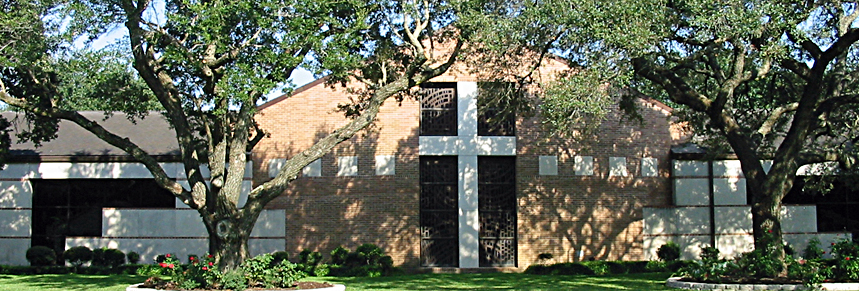
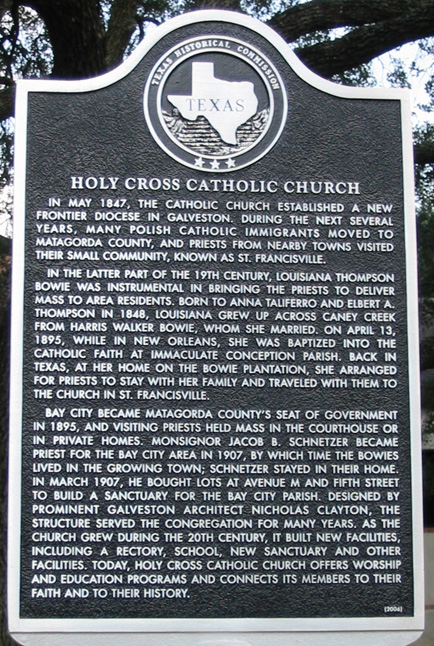 The Reconstruction and its aftermath
were drawing to a close in the United States. The Catholic Church in New
Orleans was experiencing rapid growth and financial strain. The major
challenge facing the Church was the incorporation of newly emancipated
African Americans into mainstream United States. South Louisiana was the
home for the large majority of African American Catholics at the end of
the Civil War.
The Reconstruction and its aftermath
were drawing to a close in the United States. The Catholic Church in New
Orleans was experiencing rapid growth and financial strain. The major
challenge facing the Church was the incorporation of newly emancipated
African Americans into mainstream United States. South Louisiana was the
home for the large majority of African American Catholics at the end of
the Civil War.
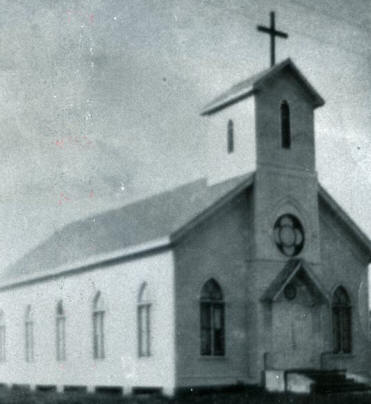 Today, Nicholas Clayton is a legend in
Texas architecture. He has “inspired one of the finest collections of
19th century, High Victorian buildings in America….”
Today, Nicholas Clayton is a legend in
Texas architecture. He has “inspired one of the finest collections of
19th century, High Victorian buildings in America….”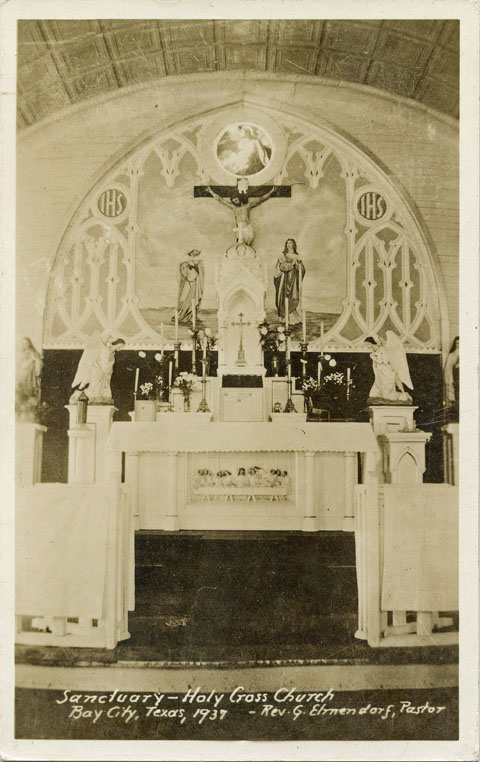 Anti-Catholicism was old and built into the very heart of the American
culture. Prior to World War I, the Ku Klux Klan still lurked in many
places. Several decades later, the Klan still had small bands of members
throughout the United States and Texas was no exception. In 1932, Father
John J. O’Reilly, a native of
Anti-Catholicism was old and built into the very heart of the American
culture. Prior to World War I, the Ku Klux Klan still lurked in many
places. Several decades later, the Klan still had small bands of members
throughout the United States and Texas was no exception. In 1932, Father
John J. O’Reilly, a native of 